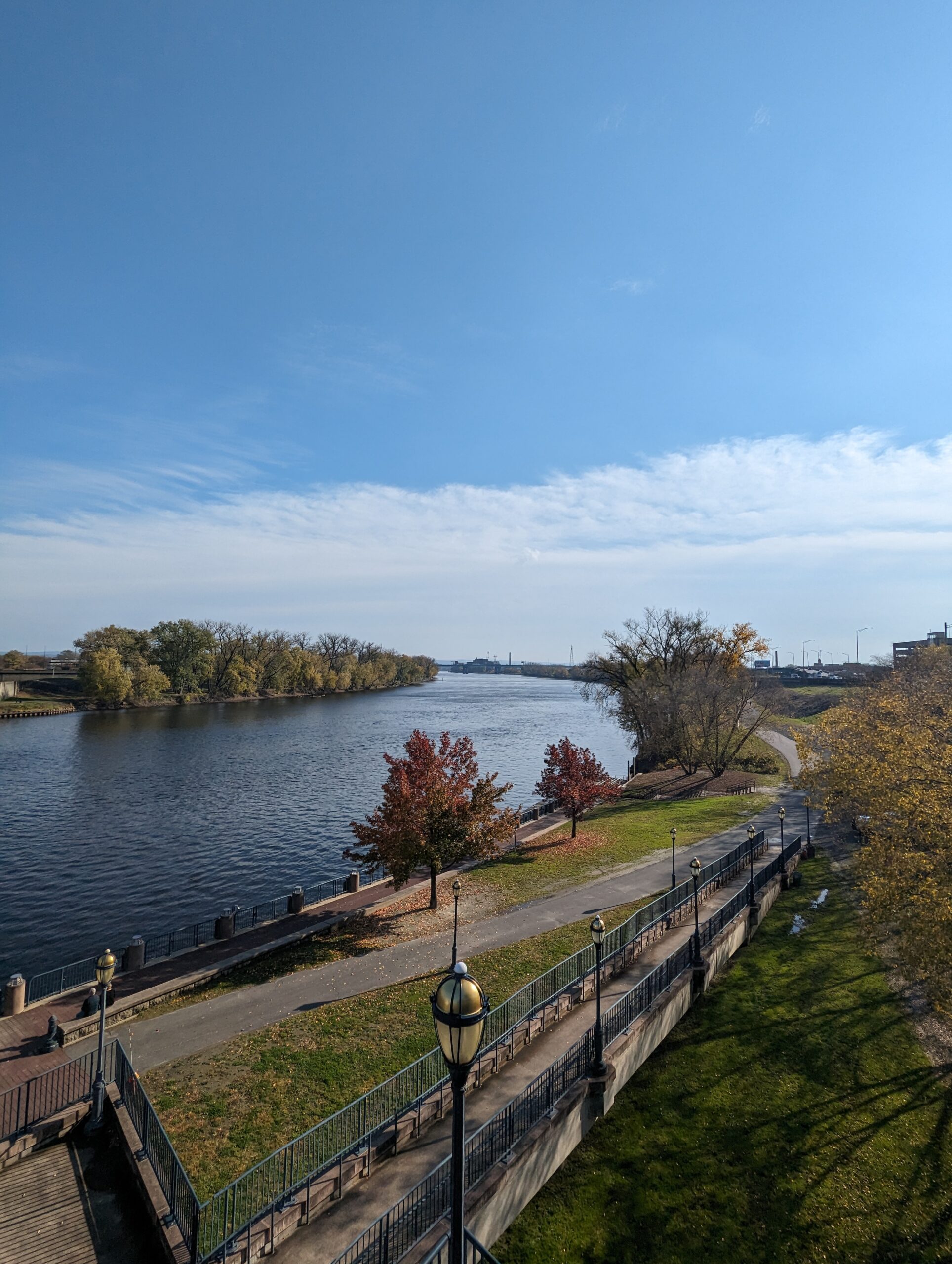Buffalo, New York State’s second-largest city, has a reputation as a declining Rust Belt city. While that has some truth to it – Buffalo’s population today is less than half of its peak in 1950 – the city’s long history has left fascinating industrial heritage. As larger coastal cities have increasingly priced people out, Buffalo’s affordability has helped many of its urban neighborhoods continue to thrive.
I went for about 24 hours in mid-March, at which point it was still very much winter in Western New York, with icy sidewalks and snow falling for much of my time there. While it wasn’t necessarily the ideal time to visit, I was still able to see many of the sights, and I’d like to think I got to experience the real Buffalo.
Architecture in Downtown Buffalo
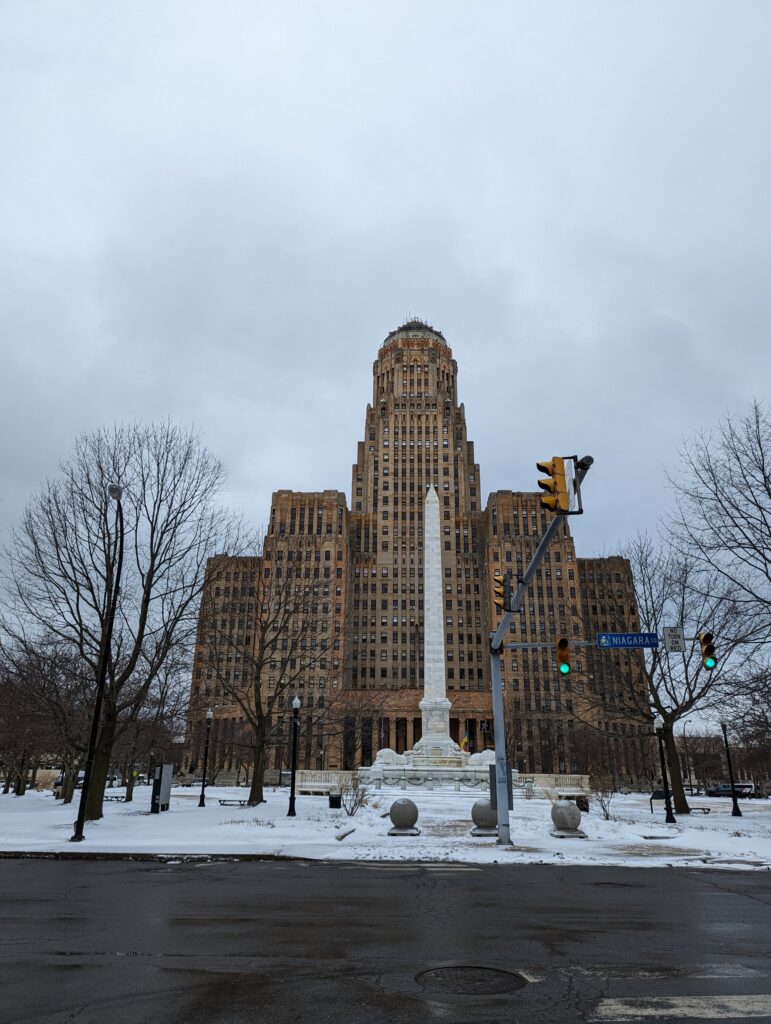
One of my top reasons for visiting Buffalo was to see the historic architecture that has outlasted the city’s economic decline. Grand buildings throughout Downtown (and farther out in the neighborhoods) are reminders of the city’s heyday in the late 19th and early 20th centuries, and many of them are remarkably well preserved.
My first stop was Buffalo City Hall, situated in the center of Downtown at the western end of Court Street. City Hall’s massive Art Deco edifice opened in the early 1930s, with an imposing podium stepping up to an ornate octagonal tower. Directly in front of the building is Niagara Square, a plaza with a monument in the center to President William McKinley, who was assassinated in Buffalo in 1901.
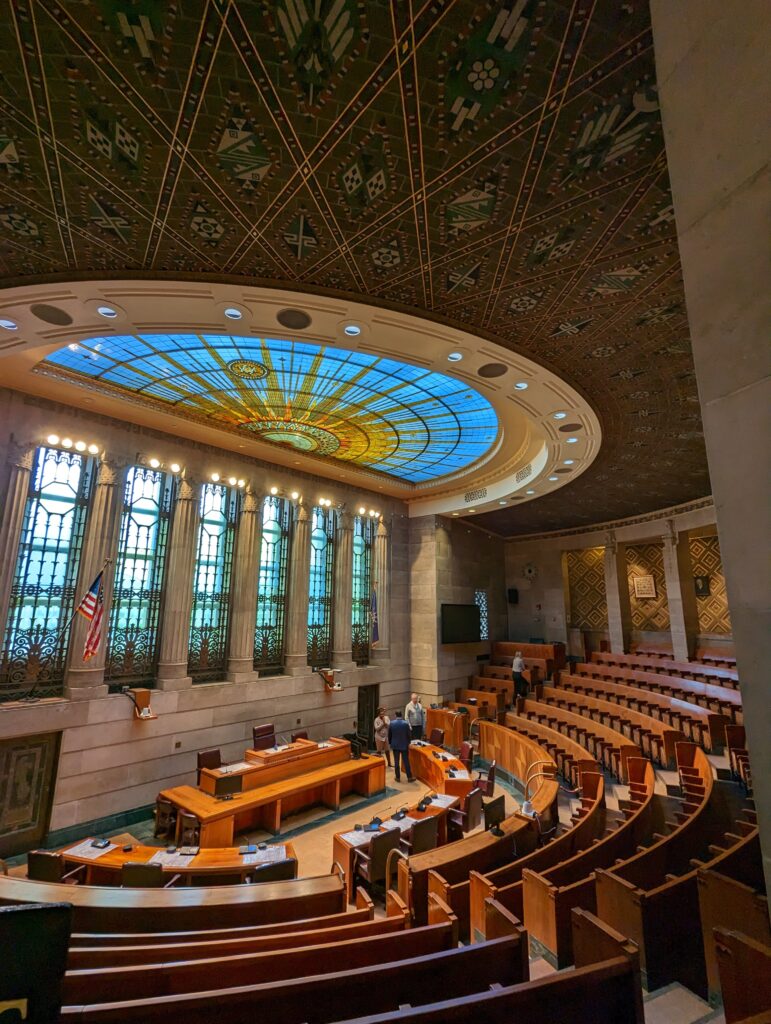
City Hall is open to the public during the day Monday through Friday. The ground floor lobby has richly detailed mosaics on its high, arched ceilings, with friezes on the walls and murals in the hallways leading out in each direction. Take a sculpted brass elevator up to the 25th floor. From there, a further staircase leads up a couple levels to the observation deck. Panoramic views extend in every direction, with the rest of Downtown Buffalo in the foreground and Lake Erie spreading out to the west. You might even a glimpse of Toronto on the northern horizon on a clear day.
When you leave the observation deck, take the elevator down to the 13th floor. There, you can see the Common Council Chambers, where Buffalo’s local legislators meet. A beautiful stained-glass skylight illuminates the semicircular space, and intricate detailing covers the walls and ceiling.
Walk back east on Court Street, where a neoclassical office tower called the Liberty Building holds not one but two replica Statues of Liberty on its roof. Turning north on Main Street, you’ll pass a light rail station.

When Buffalo built its light rail in the 1980s, it put trains in a tunnel through suburbs and outlying neighborhoods while running them on the street in the middle of Downtown – the reverse of what most light rail systems do. It initially ran on an exclusive transit mall down Main Street, but the city recently allowed traffic to return, sharing the tracks with trains, with the goal of rejuvenating local businesses. There are now some thriving businesses along these blocks, including the popular OSB Ciderworks, although it’s hard to know whether sacrificing transit priority was necessary for their success.
At Huron Street are some more architectural gems. The Buffalo Savings Bank is an impressive neoclassical bank branch with a large, gilded dome. You can step inside and see the ornate interior during business hours. Down the block is the Electric Tower, a Beaux Arts office building with an octagonal tower (apparently a popular shape among early 20th century Buffalo architects) stepping up to a spire. The tower is the site of a New Years Eve ball drop like the one across the state in Times Square. For a quick break, check out overwinter coffee or Fattey Beer Co., which look out over a small triangular plaza in front of the bank building.
Afterwards, head back south on Main Street a few blocks. At the corner of Church Street is St. Paul’s Episcopal Cathedral, designed by the same architect as Trinity Church in Lower Manhattan and opened in 1851. It was heavily renovated in the 1880s after a major fire.
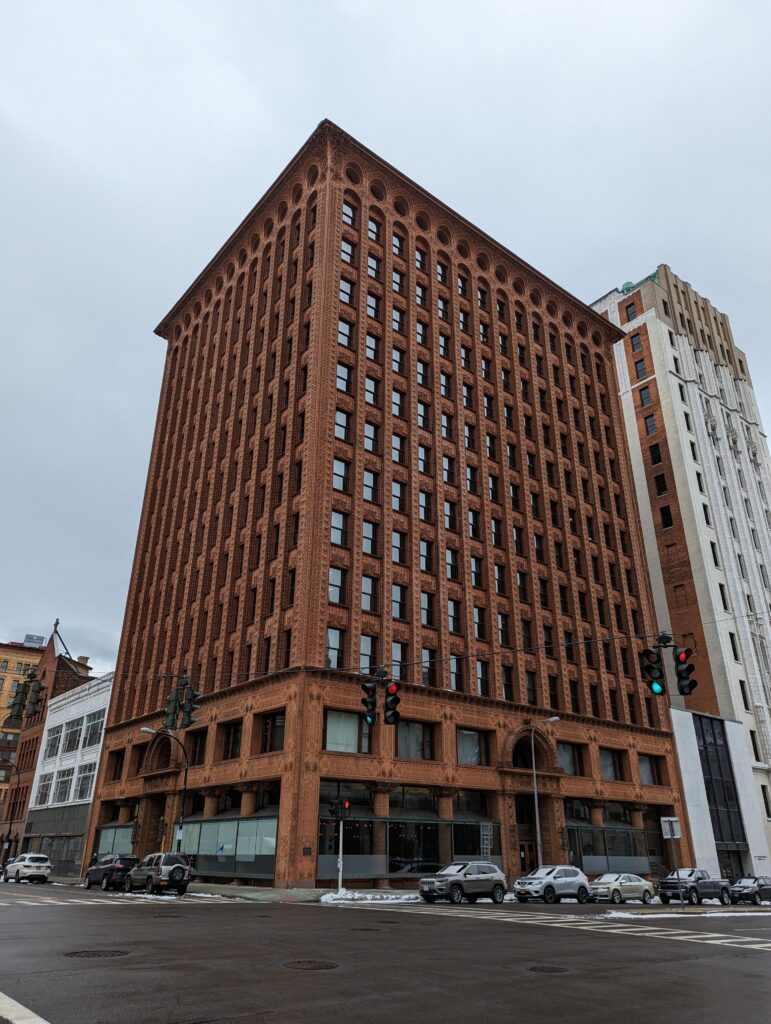
A block west down Church is one of Buffalo’s top architectural landmarks: the Guaranty Building. The building was designed by Louis Sullivan, one of the most prominent American architects of the late 19th and early 20th centuries, along with his partner Dankmar Adler, and opened in 1896. The building is notable for being one of the first skyscrapers in the world, with its steel frame allowing a much lighter, taller building than possible in a heavy, stone structure.
While the building may look somewhat unremarkable today from farther away, the intricate detailing on its terra cotta façade becomes apparent as you approach it. Although Sullivan was an early modernist, coining the adage “form follows function” to emphasize a general aversion to non-function ornamentation, he covered the Guaranty Building with beautiful, organic designs, along with sculptural light fixtures and lobby interiors.
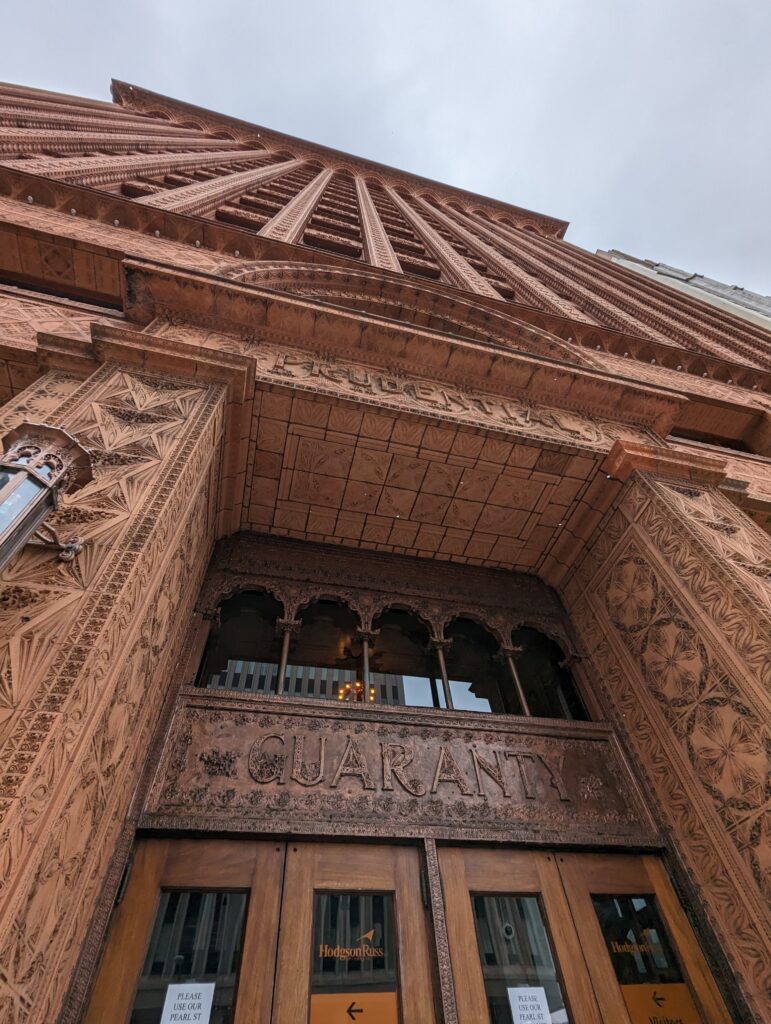
As Buffalo’s economy declined in the mid-20th century, the building fell into disrepair. Renovations covered up many of its interior and exterior design elements, and a fire in the 1970s led to talk of demolition. Preservationists mobilized to save the building, with government funding stabilizing it in the 1980s. In the early 2000s, a local law firm bought the building and undertook a heavy renovation, restoring it to its former glory. Today, the law firm has its headquarters upstairs, while the ground floor has a small exhibition about the building that is open to the public.
There are a couple other noteworthy buildings near the Guaranty Building that I didn’t get to see on this trip. A block west of the Guaranty Building is the Old City and County Hall that opened in the 1870s and housed both municipal and county offices before the current City Hall opened in 1930. Its grand stone Romanesque façade and clock tower are surrounded by grounds designed by Olmstead and Vaux, who also designed Central Park in New York City. A few blocks east is the Old Post Office, a full-block Gothic Revival building that opened in 1901 and now hosts SUNY Erie, a local community college. Inside is a huge, airy atrium covered by a skylight.
History on the Buffalo Waterfront
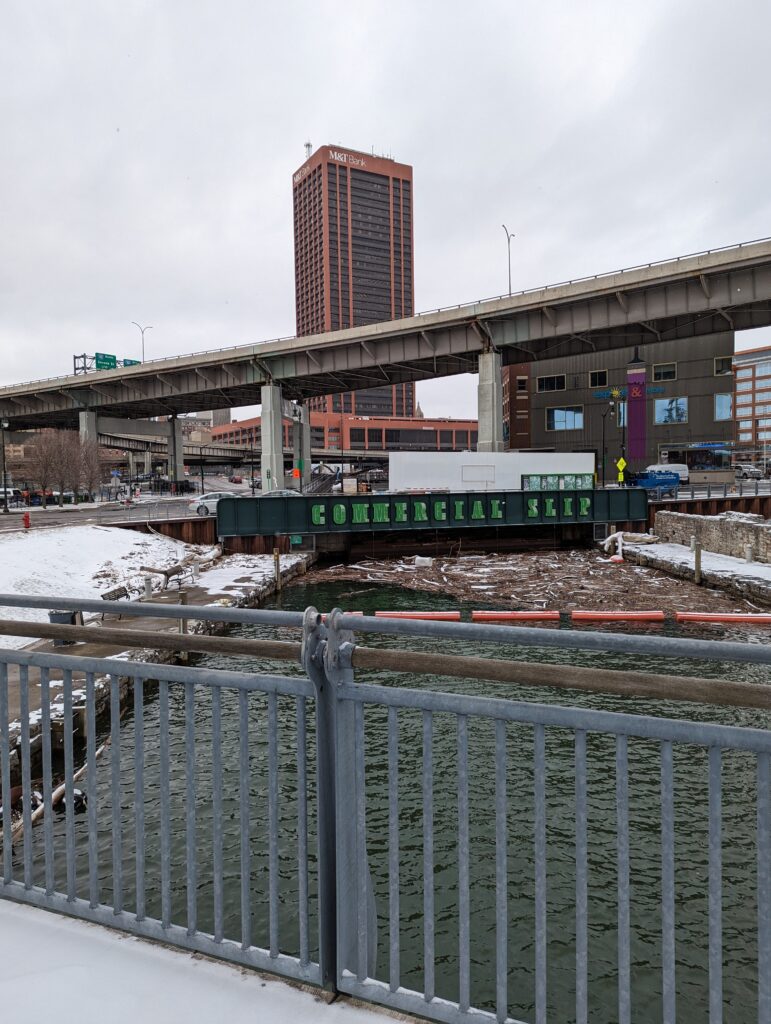
Unfortunately, as in many American cities, Downtown Buffalo is cut off from its Lake Erie waterfront by elevated highways. However, it has been working to revitalize the portion of the waterfront nearest to Downtown, around where the Buffalo River meets the lake. There, a new park, called Canalside, celebrates the location where the Erie Canal began when it opened in 1825. The area is at the end of the light rail line, easily accessible from central Downtown and the northern neighborhoods.
The importance of the Erie Canal to Buffalo is difficult to overstate. Before it opened, there was little European settlement in the area. The canal provided a fast, reliable way to move between the Hudson River at Albany and the Great Lakes at Buffalo, leading to the rapid development of the city where goods from the Midwest could be transferred from large lake ships to narrow canal boats to continue to the Eastern Seaboard. At the same time, the canal accelerated the dispossession of land from the nations of the Haudenosaunee (Iroquois) Confederacy, including the Seneca, whose homeland includes what is now Buffalo.
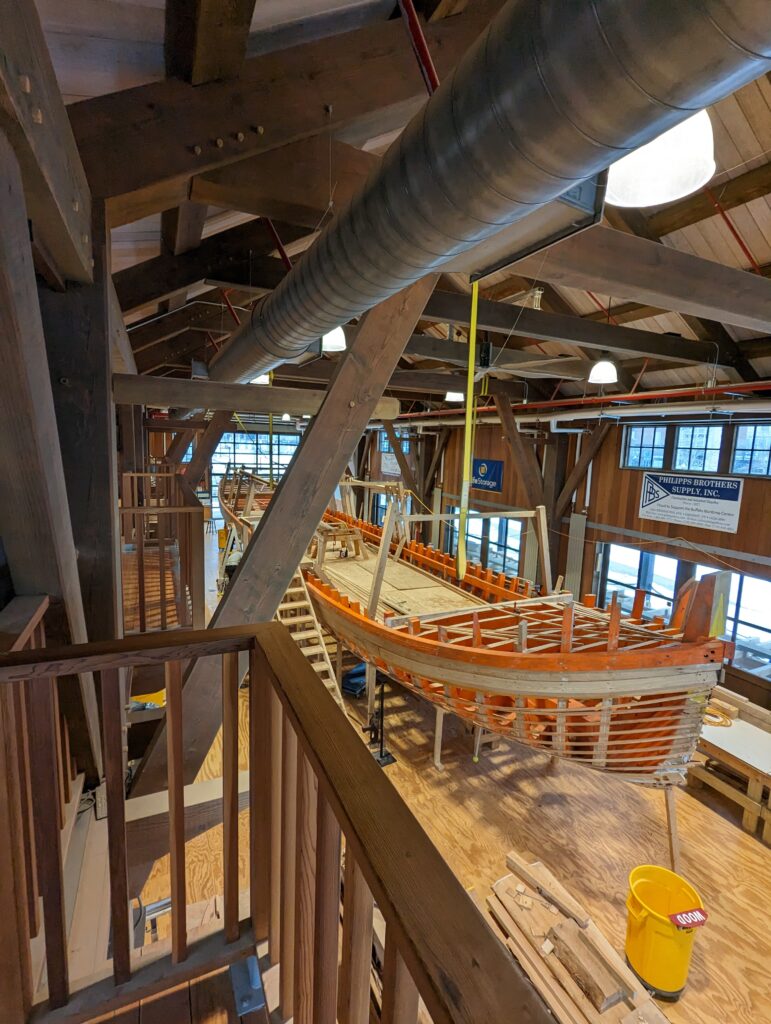
While the Erie Canal was relocated away from the center of Downtown Buffalo long ago, Canalside preserves its first couple hundred feet. On one side of this remnant of the canal is the Longshed, which has exhibits about the Native American history of the area. When I visited, dozens of people were building a long wooden boat in the middle of the Longshed. They explained to me that they are volunteers building a full-scale replica of the first boat that traveled the length of the Erie Canal in 1825, carrying Governor DeWitt Clinton from Buffalo to Albany. They plan to complete it by the canal’s two hundredth anniversary in 2025, when they will recreate that voyage.
On the other side of the canal is the Buffalo Naval Park, which preserves old naval ships and planes, and a dock where boats provide tours out on the river and lake (understandably not in the frigid winter, when I visited). In the summer, Canalside hosts events and kayak rentals. Within a few blocks are KeyBank Center, where the NHL Buffalo Sabres play, and (on the Downtown side of the freeways) Sahlen Field, where the Bisons, Buffalo’s AAA minor league baseball team, play. Nearby breweries include Pearl Street Grill & Brewery, which has been around since the 1990s in a multi-level historic building, and the Buffalo outpost of Southern Tier, a popular craft brewery from a small town 60 miles to the southwest.
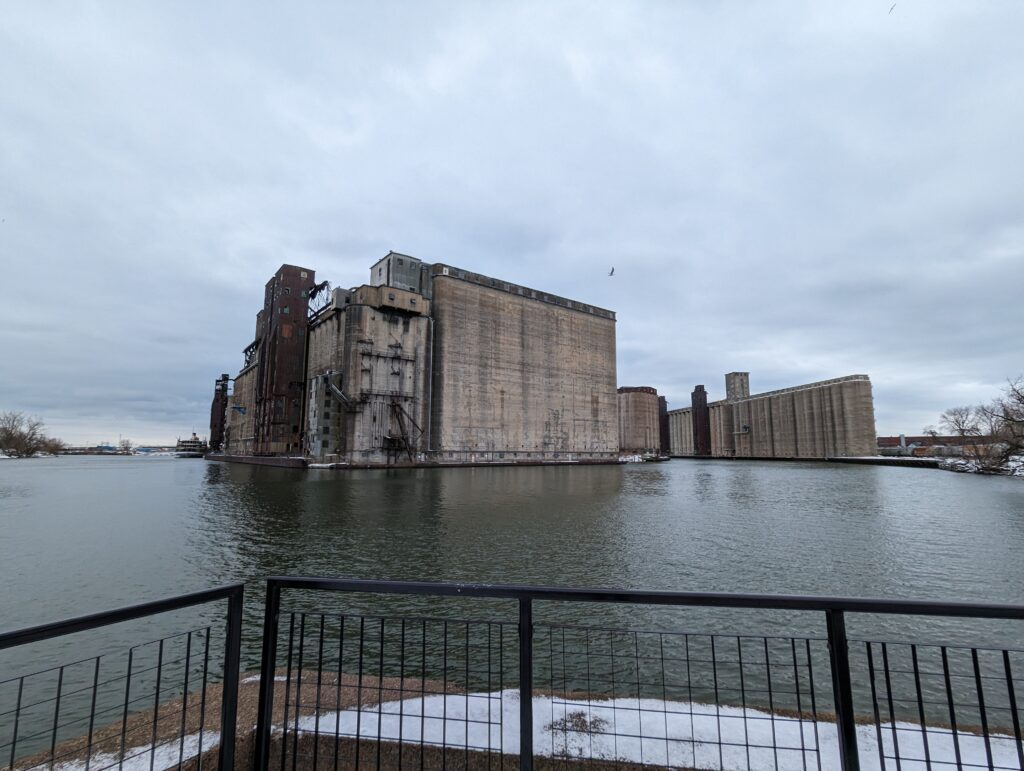
Farther down into a more industrial part of the waterfront (and harder to visit without a car) is Silo City, a long-vacant warehouse complex where massive grain silos tower over the Buffalo River. Now, the complex is undergoing a revitalization process, with developers converting old warehouses to residential, commercial, and art gallery space. Already, a bar (Duende) has opened in a small old office building on the site, with outdoor seating in the shadow of the silos. Mutual Riverfront Park, across the river from Silo City in the Old First Ward, provides a dramatic vantage point to see the silos rise out of the water.
Vibrant Northern Neighborhoods
North of Downtown are a string of walkable urban neighborhoods that have retained their historic architecture and business districts despite Buffalo’s population decline. I stayed in Allentown, the first neighborhood north of Downtown, with the light rail providing easy access. Old brick mansions and wooden Victorians line the side streets, while independent bars, restaurants, and cafes are at the base of apartment buildings on Allen Street. The Intersection just off Allen is a great coffeeshop with a community feel, and Gabriel’s Gate, in an old house on Allen, is a classic spot for Buffalo’s famous chicken wings.
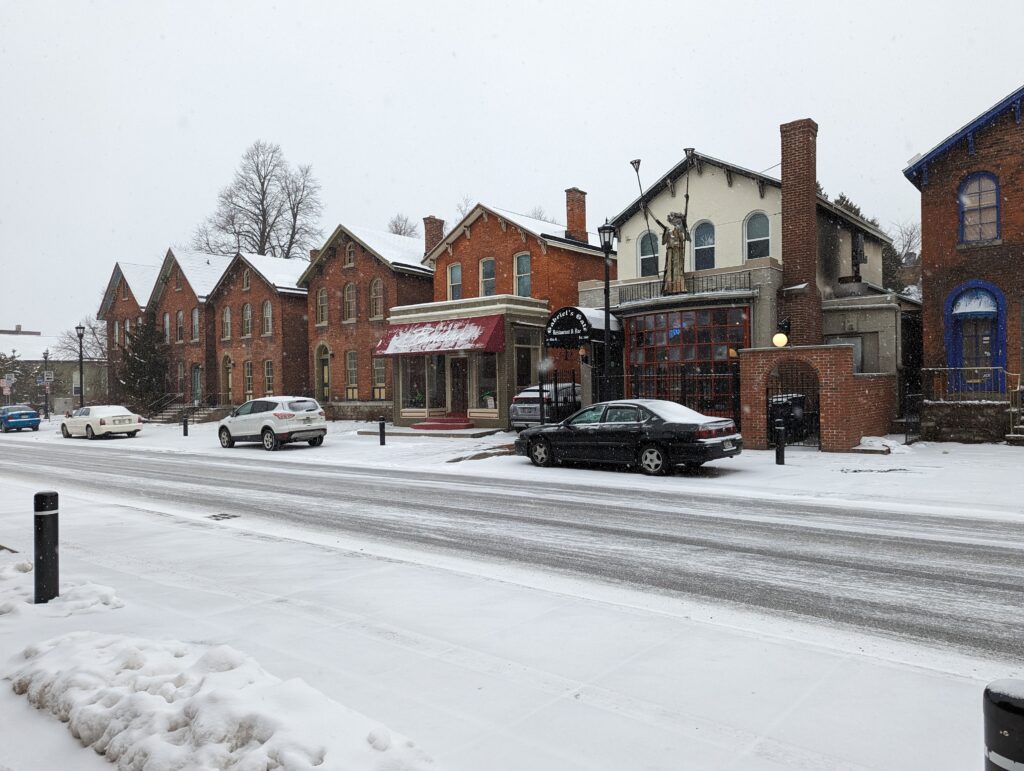
Allentown has a few more specific attractions. Theodore Roosevelt Inaugural National Historic Site is a museum in the mansion where Theodore Roosevelt was inaugurated in 1901 after President McKinley was assassinated at the World’s Fair in Buffalo. A few blocks west, at Symphony Circle, is the Kleinhans Music Hall, home to the Buffalo Philharmonic Orchestra. The modernist building, designed by Eliel and Eero Saarinen, didn’t look like much from the outside, but the interior is supposed to be impressive. Up along Delaware Avenue are some of Buffalo’s most elegant mansions; as a lover of brutalism, I loved the sculpted concrete Temple Beth Zion synagogue amid the much older architecture.
North of Allentown is Elmwood Village, centered on the bustling Elmwood Avenue. I went to Thin Man Brewery on Elmwood for drinks and dinner (including, of course, wings) – the brewery is named after a quirky piece of local history, the “thin man” crash test dummy, which was invented here in Buffalo to simulate the effects of a car crash on the human body. Just west of Elmwood Village is the small Five Points neighborhood, which is rapidly growing in popularity. The cafe Remedy House anchors the area’s namesake five-way intersection in a historic flatiron-shaped building, with bakeries and boutiques across the street.
Farther Afield in the City
North of Elmwood Village is another site I didn’t get to visit: the Richardson Olmsted Campus. The Campus opened in 1870 as a state facility for treatment of mental illness, with an imposing Romanesque building designed by H.H. Richardson in the center and grounds laid out by Olmsted and Vaux. The complex stopped housing patients in the 1970s. In the last ten years, the state has been working to renovate and reuse the site, with the central building reopening as a hotel and conference center in 2017. Tours are available in the summer that detail the architectural history and the evolution of mental healthcare philosophy.
To the east of the Richardson Olmsted campus are the Buffalo AKG Art Museum, Delaware Park, and Forest Lawn Cemetery. The museum, in a grand neoclassical building, is under renovation but set to reopen in summer 2023. Delaware Park is a large 19th century park, also designed by Olmsted and Vaux in the tradition of Central and Prospect Parks in New York City. The cemetery abutting the park dates to the 1840s – famous people buried there include Millard Fillmore, Rick James, and Shirley Chisholm.
A few blocks north of Delaware Park, you can visit the site where President William McKinley was assassinated in 1901. The assassin, an anarchist named Leon Czolgosz, shot him at the Pan-American Exposition, a World’s Fair taking place in Buffalo that year. The president survived for a week after the shooting before succumbing to his wounds. The Exposition was made up of temporary buildings that were dismantled after the fair, so the site is now on a quiet residential street, marked only by a rock with a small plaque.
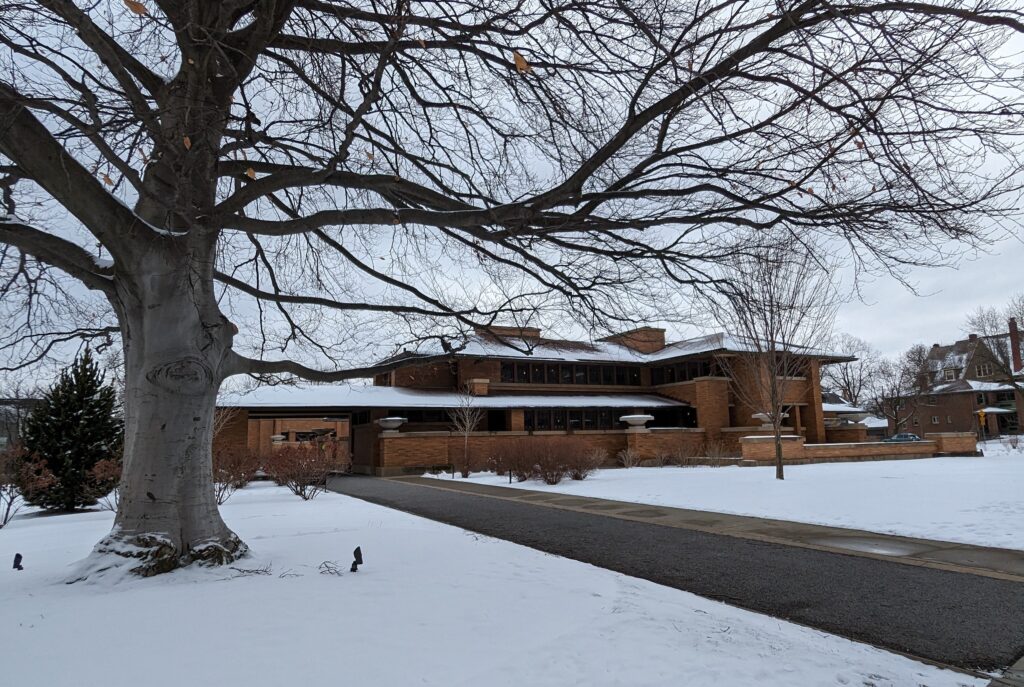
East of the park is yet another architectural attraction in Buffalo: Frank Lloyd Wright’s Martin House. Considered one of the architect’s finest works, the house was completed in 1905 in Wright’s signature Prairie School style. It fell into disrepair and was nearly demolished in the mid-20th century (and some outbuildings were in fact demolished), but a non-profit acquired it in the 1990s and fully restored the house and its grounds. It is now open for public tours.
In a different part of the city, a couple miles east of Downtown in the historic Polonia neighborhood, is Buffalo Central Terminal. Formerly the city’s primary train station, the Terminal building houses a huge waiting hall and a 17-story Art Deco tower. The station was abandoned in 1979 when trains were rerouted and has been boarded up ever since. However, state and local agencies are working to restore and reuse the building as a regional event venue, whether or not train service is restored.
Near the Terminal is the Broadway Market, an indoor market with dozens of vendors that has been around for decades. Many of them sell Polish goods, reflecting the Eastern European history of the neighborhood.
Around Buffalo
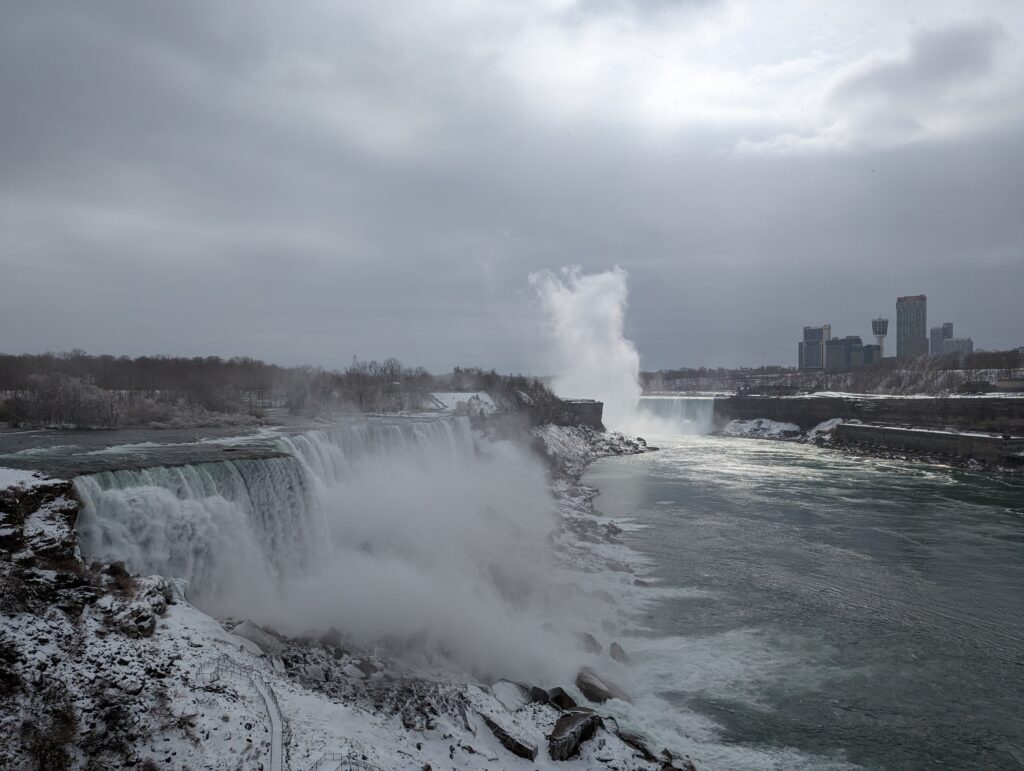
Probably one of the top reasons people come to Buffalo in the first place is its location just south of Niagara Falls. The Falls themselves are spectacular and worth visiting despite the summer tourist mania. However, the city of Niagara Falls is a prime example of the failure of urban renewal. The city grew rapidly in the early 20th century, with a robust industrial and tourism-based economy, and its population peaked at over 100,000 in 1960.
However, like its neighbors, Niagara Falls underwent a rapid decline starting in the 1960s. In an ill-fated plan to reverse that decline, the city (with federal support) demolished almost all of its historic downtown, replacing it with an outlet mall and casino. Those have never been very successful, and Downtown Niagara Falls today feels desolate. Meanwhile, its twin city of Niagara Falls, Ontario, on the Canadian side of the border is comparatively thriving.
A half-hour drive east of Niagara Falls is the town of Lockport. Located on the Erie Canal, Lockport is famous for its impressive system of locks that has carried boats up and down a steep escarpment for 200 years. The Erie Canal Discovery Center has exhibits about the locks and the history of the canal in general, and operators offer boat tours through the locks and into caves in the area. Steamworks Coffee, right on the canal, is a great place to stop.

